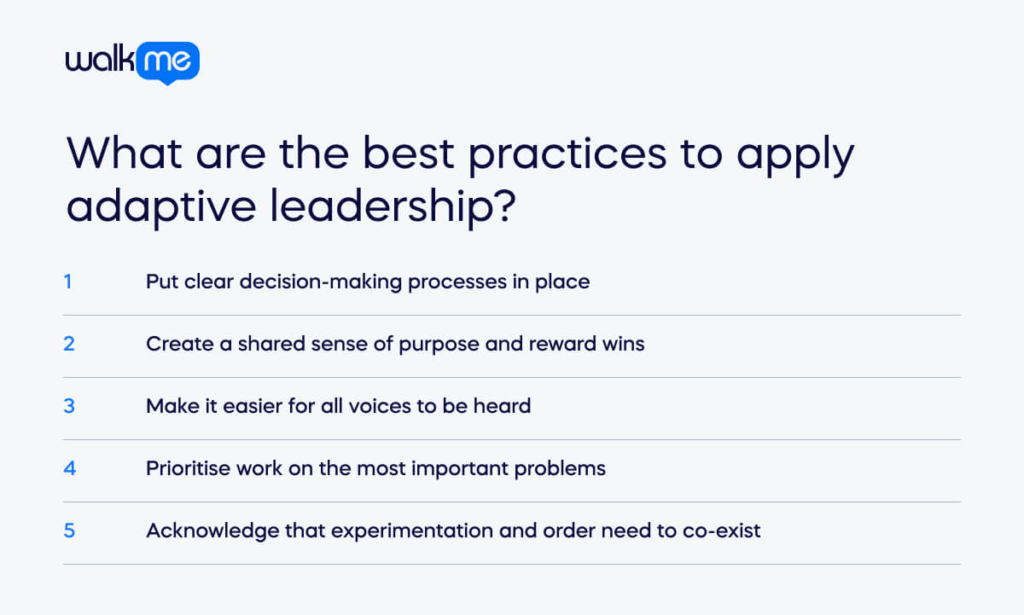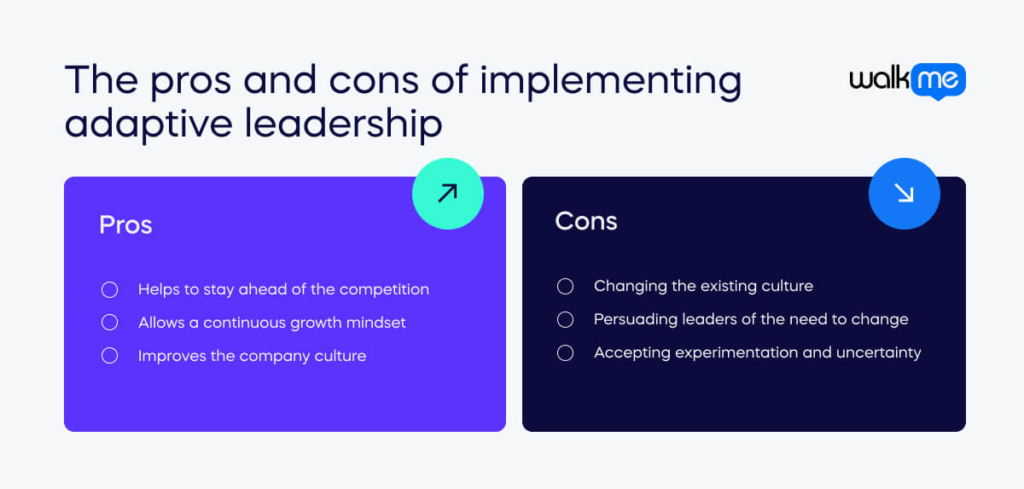When a business thrives, it’s easy to think nothing can go wrong. Business is booming, competition seems distant, and the future looks bright. However, even top companies can face struggles when things change.
Small shifts, like changing customer experience or new competitors, can affect your market share. When this happens, you need a plan to get back on track. Today, leadership is not just about maintaining the status quo. It requires a new approach due to rapid business changes and global events like the pandemic.
The old ‘command and control’ leadership style is no longer enough. Change is constant, so teams need to be adaptable and flexible. Leaders who encourage change can solve problems and handle new situations better. Adaptive leadership is not just a set of skills; it’s a mindset for thriving in uncertain times.
This article will explain adaptive leadership, how it differs from other styles, and its main principles, best practices, benefits, and challenges.
What is adaptive leadership?
Ronald Heifetz introduced adaptive leadership in his 1994 book, ‘Leadership Without Easy Answers.’ Heifetz created this concept to help leaders face challenges in complex and fast-changing environments.
The key idea is that leaders should let their teams solve tough problems together instead of providing all the answers. Leaders should build a culture of learning and innovation, an environment where team members can experiment, learn from mistakes, and adapt.
This type of leadership differentiates between ‘technical’ problems and ‘adaptive’ problems. The former can be solved with existing knowledge, while the latter needs new learning and innovation. Leaders should act as educators and facilitators, not just problem-solvers.
This leadership style is especially useful in today’s rapidly changing world. It promotes personal flexibility and a culture of adaptability. This encourages open-mindedness, continuous training, and new ideas.
How is adaptive leadership different from other leadership styles?
Adaptive leadership differs from other styles because it proactively responds to challenges and changes. Instead of sticking to the usual methods or obvious solutions, it encourages leaders to embrace uncertainty and learn from new opportunities. It values diverse perspectives within the organization.
In contrast, autocratic leadership means the leader makes all the decisions with little input from the team. This approach can be useful for quick decisions but may lower employee morale and creativity.
Also, situational leadership focuses on adjusting to the needs and skills of individual team members. Leaders provide more guidance to those who need it and give more freedom to those who are capable. This is similar to servant leadership.
But, adaptive leadership looks at the bigger picture. It emphasizes adapting to new challenges and opportunities, questioning the status quo, and finding innovative solutions. This style promotes flexibility and teamwork.
What are the main principles of adaptive leadership?
The top principles of adaptive leadership to follow are:
Ongoing development
The adaptive leadership model understands that organizations must change to stay relevant in a constantly evolving market. Adaptive leaders know that developing individuals is as important as making organization-wide changes.
Organizations adapt best when team members have a growth mindset. This commitment to learning starts with leaders who join their teams in training. Leaders and teams can attend conferences, workshops, and webinars together to find new ways to handle challenges.
Adaptive leaders like to try new strategies and processes to help the organization succeed. They are willing to innovate and experiment, even if they might fail. You can also encourage employees to reach their full potential.
Character
As an adaptive leader, you need a strong sense of right and wrong. Your honesty and ethical behavior will build trust and respect in your team. Be truthful, take responsibility for your actions, and learn from your mistakes. This will set an example for others and create a culture where integrity guides all decisions.
Self-awareness is also key. They know their strengths and weaknesses, which helps them see where they can grow. They understand others well, allowing them to build strong, collaborative relationships. This self-awareness earns them the respect and trust of their teams. It also helps them guide their organization through changes and challenges.
Emotional intelligence
Change is hard, but emotional intelligence helps you handle it well. Being aware of your emotions enables you to understand and manage your own feelings and those of your team. This is very useful during stressful times. It helps you calm your team and solve conflicts.
Adaptive leadership values relationships. Good leaders ensure everyone feels heard and supported while solving problems. This requires emotional intelligence, which means handling relationships with empathy and awareness.
These types of leaders also check in with stakeholders to ensure they know about changes and can give feedback. Positive relationships and high employee morale are key to adaptive leadership.
Organizational justice
Adaptive leaders ensure fairness in their organizations by promoting fair processes, outcomes, and treatment of everyone. This builds trust, increases engagement, and creates a culture of openness and respect. Input from everyone is important in adaptive leadership, and a culture of fairness and justice is essential for making adaptive changes.
Organizational justice also refers to an environment that accounts for more than the leader’s voice. All voices should have a chance to speak. Solving problems and making decisions relies on the whole team. Different ideas and perspectives are vital for success and should be encouraged by a good adaptive leader.
Collaborative problem-solving
Great adaptive leaders use creativity and think outside the box to find new solutions to challenges. They are open to taking smart risks and letting go of what no longer works for the company. This approach can lead to big gains for many people and give your brand a competitive edge.
A leader could start this practice with a monthly meeting with department heads. Gather them together and focus on the biggest problems within areas like customer service, marketing, and finance. For instance, although your brand performs well with women, you might want to expand your reach to men.
What are the best practices to apply adaptive leadership?

The best practices you can use to apply adaptive leadership are:
Put clear decision-making processes in place
Decision-makers need to be clear about their assumptions and decisions. They should explain what is being done, why, and how to maintain trust if mistakes are found.
Adaptive leadership means constantly evaluating and improving actions based on what is learned. Teams should follow clear steps: choosing actions, gathering evidence, and measuring success. They should collect data regularly and adjust actions based on changes.
Encourage experimentation with the understanding that failure is part of learning. Provide time and resources for new projects and ideas. Create a platform for sharing lessons from successes and failures.
Create a shared sense of purpose and reward wins
You can motivate your team by sharing a clear vision of your organization and its mission. Make sure this vision or change matches your team members’ values to give their work more meaning.
Before you can influence others, you need to connect with them personally. This means understanding their beliefs, values, and concerns. Source early feedback from employees to appreciate the best way to roll out a change.
Recognize your team members’ achievements. Rewards don’t have to be money. Depending on their motivation, you could offer interesting projects or extra responsibility. By rewarding them, you build their loyalty and commitment to the organization and your goals.
Make it easier for all voices to be heard
Empower others to play an active role in facing the challenge. An adaptive leader encourages people to think for themselves and make decisions. They show confidence in people’s ability to solve problems.
Giving the right guidance and structure helps people feel secure in their choices as they handle adaptive challenges. An adaptive leader knows that letting go of some control allows everyone to be more involved, independent, and responsible. This can lead to a greater commitment from the group.
Listen to everyone’s ideas, especially those often overlooked or different. All voices are important when solving adaptive problems.
Prioritise work on the most important problems
Being an adaptive leader requires understanding the difference between technical and adaptive problems. Technical problems have clear solutions and can be solved with existing skills and knowledge. Adaptive problems are less clear and need new thinking. They often require changes in values or behavior and do not have one right answer.
These types of challenges may need creative problem-solving and a culture of learning. Adaptive leaders need to explain why change is necessary. They involve everyone in the process and help the team see change as an opportunity for growth and innovation. They should ask if current methods are enough or if new skills and approaches are needed.
Acknowledge that experimentation and order need to co-exist
Adaptive leaders need to balance keeping things steady and encouraging innovation and change. They understand that stability and change can coexist.
Leaders can encourage their teams to question the status quo by creating regular feedback sessions. These can be used to encourage employees to critique existing processes. At the same time, they can help their team recognize which values, goals, and processes should stay the same.
Instead of looking for perfect answers, they accept that the world is complex. In this way, adaptive leadership requires leading using different ideas at once. Your employees can also learn from this behavior and use this mindset.

What are the benefits of adaptive leadership?
The main benefits of adaptive leadership are:
Helps to stay ahead of the competition
Adaptive leadership can help businesses stay ahead of others. Leaders who anticipate market changes, customer needs, and new technologies can make smart decisions and embrace risks and new ideas, leading to better performance.
Instead of sticking to a fixed plan, they stay flexible and adjust their strategies as needed. This adaptability helps them seize unexpected opportunities and handle tough times well.
Allows a continuous growth mindset
This type of leadership promotes continuous growth and learning. Adaptive leaders understand that curiosity and learning from mistakes lead to innovation. They encourage teams to explore new ideas and try different methods.
Also, leaders can create a safe space for open dialogue and feedback. This helps people feel comfortable pushing boundaries. A culture of learning also boosts creativity and resilience. It allows the organization to adapt and succeed through change.
Improves the company culture
Adaptive leadership values input from everyone in the company, making the work environment more inclusive. These leaders don’t rely only on their own expertise. Instead, they delegate authority, allow team members to make decisions, and encourage collaboration.
They use each person’s unique skills and ideas by sharing leadership duties. This helps everyone reach their full potential and succeed together. Team members feel valued and motivated, creating a positive company culture. This leads to happier and more productive employees.
What are the challenges of implementing adaptive leadership?
The key challenges of implementing adaptive leadership are:
Changing the existing culture
People could resist moving from traditional to adaptive leadership because they’re unsure what to expect or don’t see the benefits.
If your team is used to working in a certain way, they might cling to old practices. To help them adapt, offer support, training, and incentives. Also, to address any worries, hold open Q&A sessions where individuals can voice their concerns and get answers.
Persuading leaders of the need to change
By sharing power and control, adaptive leaders spread decision-making across the organization. Some senior leaders might struggle with this change, as they are used to making decisions themselves.
Also, adaptive leaders recognize when current practices aren’t working well. This can be tough for some leaders who remember when these practices were first implemented. They might resist new methods and prefer sticking to old ways.
Accepting experimentation and uncertainty
Adaptive leaders must help everyone adjust their thinking and act like adaptive leaders. They understand that some problems are complex and not straightforward. They are okay with uncertainty, encourage new ideas, and explore different solutions.
But if you’re not an adaptive leader, you might find accepting uncertainty challenging. Many leaders prefer clear, simple solutions and fear complexity. They often try to control situations to avoid ambiguity, which can make their decisions inflexible and slow to adapt.
Adopt adaptive leadership to experience financial and collaborative gains
Adaptive leadership means embracing and encouraging change throughout the company. Though tough, challenging the status quo leads to long-term financial and collaborative success.
You need this type of leadership to handle adaptive challenges. Leaders should welcome differences and be willing to adjust. They should also show emotional intelligence and keep an open mind.
Everyone’s opinions matter. Team members are trusted to solve problems, even in crises.
It also taps into the collective expertise and creativity of the whole organization. It helps guide teams through change by addressing complex challenges. Leaders mobilize and motivate people to adapt their values, beliefs, and behaviors.
FAQs
The adaptive leadership model focuses on three main concepts. First, it distinguishes between what traditions are essential (precious) and what can be changed (expendable). Second, it promotes experimentation and smart risks, viewing failures as learning opportunities. Third, it involves regular, disciplined assessment of progress and strategies, using data to guide decisions.
Adaptive leadership identifies two types of problems. Technical problems have clear solutions and can be solved by a small group of professionals. Adaptive problems are vague and complex, requiring input from many people and more time to resolve. While technical leadership is useful for specific challenges, adaptive leadership is crucial for those with broader organizational responsibilities.
A successful adaptive leader is goal-oriented, linking changes to long-term goals and acting with clear results in mind. They are open-minded, create a flexible environment, and accept mistakes as part of learning. They appreciate challenges, prepare their team for problem-solving, and commit time to change.
Adaptive leadership is helpful in various situations. During a crisis, it involves quickly assessing the situation, gathering input, and exploring solutions while keeping the team calm and focused. When implementing change, explain the reasons, involve everyone, and help the team view change as a growth opportunity. It requires flexibility, staying connected to the environment, and encouraging the team to see uncertainty as a chance to learn and adapt.

